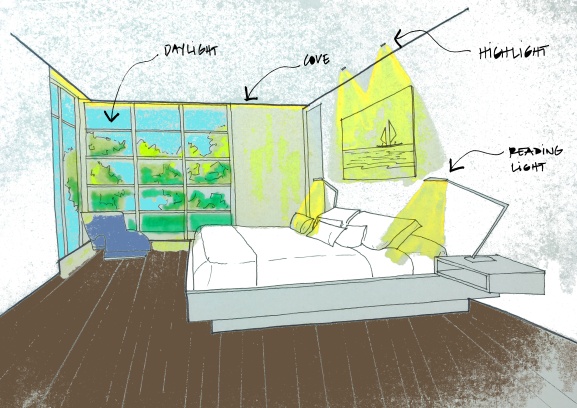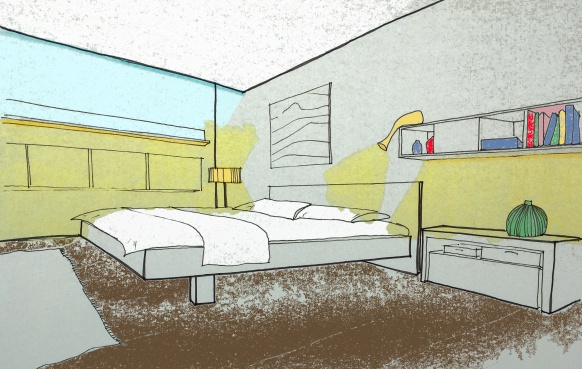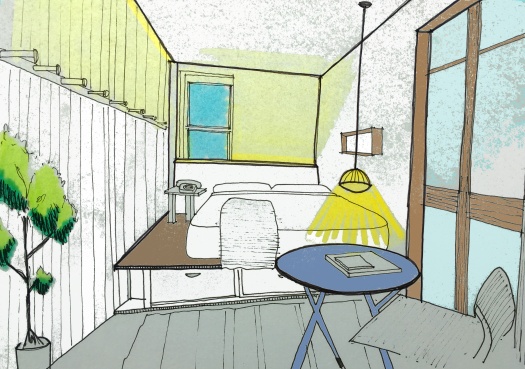The bedroom is that space at home, where we relax the most. Therefore, the lighting should be as minimal, as integrated and as beautiful as possible. There are many ways of lighting the bedroom space and we’ll be showing some examples here to help you decide what to do with your space.
Firstly, some layers of light can be defined in order to help structure your plan. These can be as listed below, but sometimes some layers come together in one lighting system, as we will see:

- Daylight – should be the main light source during the day. It will connect people to the exterior and help them synchronise their circadian clock. It is quite important to have a view of the sky from the bedroom. Large windows will help give the sense of openness and brightness. Beware if you are someone who’s not so keen on having bright daylight in the very early mornings in summer. If that is the case, introduce a dark curtain to “cut” that light, which can disturb your sleep.
- Reading lighting – some people like to read a book before switching off the lights and sleeping. Therefore, a good reading light should be provided. The technicalities for the luminaires will depend on the user and how she/he would like to have the light. This is a very personal choice, since it will be used by mainly one person only. Nevertheless, choose a luminaire which you can control in terms of where the light is going to. That way you can have direct or indirect light, as you like. Luminaires with a dimmer are a good option too.
- General lighting – general lighting should be provided for orientation as well as cleaning. Usually people place a pendant in the centre of the space. It doesn’t necessarily have to be that way. The general lighting can be something interesting as well, either as highlight of some art piece, or plant, or a cove. In general, we tend to mix the layers of light to provide general lighting. Try some of the layers listed here for your space.

- Integrate the of lighting equipment where possible – also in the bedroom, it is important to integrate the light sources where you can – coves, niches, slots, etc are very useful for creating sometimes unexpected and beautiful details for lighting. At the end, what we like to see is the effect of light touching materials and not the light source itself.
- A highlight – if there’s something interesting in the room you would like to draw attention to, it’s important to highlight it with light. A nice painting, a plant, a sculpture, an instrument – whatever you feel is worth some accent deserves a little extra lighting.
- Night-light – some people like to have at least a little light during the night, so if they need to wake up, they don’t have to switch on a bright light. This can be the little plugs you can get in any dedicated shop or a special lighting integrated into a low-level furniture (as shown in some examples here), which is sure to be hidden and not cause glare at night.

Some large bedrooms also feature a reading corner. For that, it might be an interesting choice to go for a standing luminaire, so you are free with moving the luminaire around. An articulated luminaire should be used, as to provide enough freedom in moving the light where you like it.
Adopt also different circuiting for the lights. It’s better to keep the lighting layers separated in case you want to have just one or two on for your bedroom time. Some people also use dimmers – which we always recommend – but that will mean a little extra budget. If you have some extra budget, why not invest in a control system and programme lighting scenes? That might be nice to have at some occasions.
And please remember to watch out for the light colour you are using! Ideally, all lighting equipment should be of the same light colour – for intimate, residential areas, we recommend 3000K (warm light tone), rather than neutral or more bluish tones. The higher the light colour, the cooler it gets, so avoid using anything above 3500K-4000K.
Hope you have enjoyed our tips for your bedroom lighting. If you have any questions, do not hesitate to contact us. And follow us for more tips!
See you in the next post!
#thelightingtips
